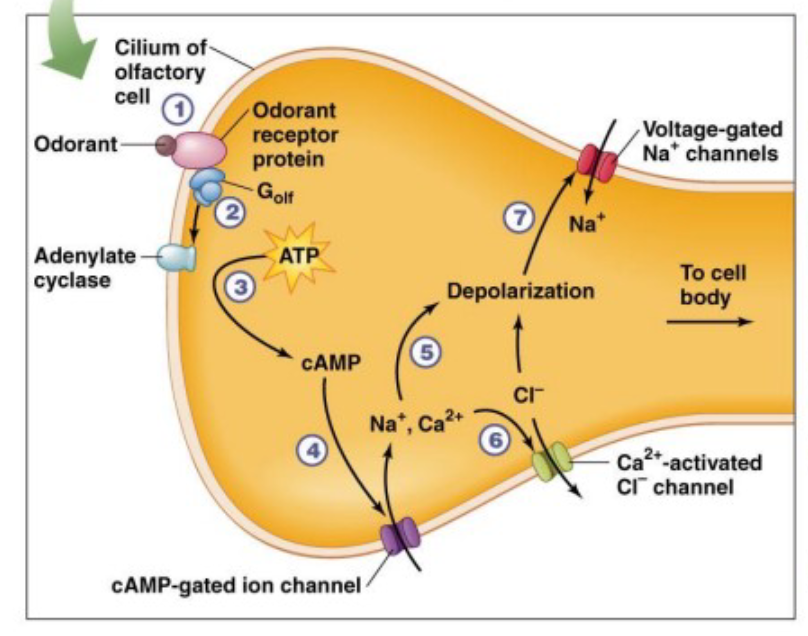Chemoreception
1/9
There's no tags or description
Looks like no tags are added yet.
Name | Mastery | Learn | Test | Matching | Spaced |
|---|
No study sessions yet.
10 Terms
Distinguish between taste and smell
Gustation (taste)
chemicals in contact with the animal
dissolved chemicals at relatively high concentrations
Olfaction (smell)
chemicals concentrated at a distance
airborne or dissolved chemicals at low concentrations
Physiological distinction
Different sense organs, different receptor cells
Different signal transduction mechanism
Separate integrating centers
Know chemoreceptive organs in terrestrial vertebrates and mammals
Vertebrates
Gustation (taste)
Taste buds
Oral cavity (tongue, larynx, soft palate)
Esophagus
Olfaction (smell)
Odorants: olfactory epithelium
Pheromones: Vomeronasal organ (vestigial in humans)
Mammals
Gustation (taste)
Taste receptors: epithelial sensory cells
Receptors potential
Taste bud:
Cluster of taste receptors (50-100)
Apical surface folded into microvilli (contain receptor proteins)
Pore
Supporting cells
Rapid turnover (10-14 days)
Describe the 5 categories of taste
Sweet
monosaccharides, polysaccharides, artificial sweeteners
Salty
Na+
Sour
HCl
Bitter
Caffeine, quinine
Umami
L-glutamate, amino acids, MSG
Describe the salty transduction mechanism
Na + channels (ENaC) also permeable to H+ (possible to detect sour taste?)
Na + compete with H +
Detection of sourness in species with low Na + in saliva (e.g. hamster)
Mechanism
Na + from salty food enters through a Na + channel
The resulting depolarization opens voltage-gated Ca 2+ channels
The influx of Ca 2+ causes neurotransmitter release
Taste preferences based on nutritional deficiencies
Salt deficiency triggers aldosterone secretion
Aldosterone enhances Na+ retention by kidney and increases ENaC expression in taste receptor cells:
Induces craving for salty foods

Describe sour transduction mechanism
Sour taste caused by H+ ions in food
Different sour transduction mechanisms
Mammal: PKD2L1 channel, acid-sensing ion channels (ASlCs)
involve pH-sensitive Na+ channels
Salamander: taste receptor cells express K+ channels
K+ channels blocked by H+
Decreased K+ permeability = depolarization
VG-Ca2+ channels opens
Increase [Ca2+], Nt released
Frogs: H+ - gated Ca2+ channels and H+ transporters
![<ul><li><p>Sour taste caused by H+ ions in food</p></li></ul><p></p><p><strong>Different sour transduction mechanisms</strong></p><ul><li><p>Mammal: PKD2L1 channel, acid-sensing ion channels (ASlCs)</p><ul><li><p>involve pH-sensitive Na+ channels</p></li></ul></li><li><p>Salamander: taste receptor cells express K+ channels </p><ul><li><p>K+ channels blocked by H+ </p></li><li><p>Decreased K+ permeability = depolarization </p></li><li><p>VG-Ca2+ channels opens</p></li><li><p>Increase [Ca2+], Nt released</p></li></ul></li><li><p>Frogs: H+ - gated Ca2+ channels and H+ transporters </p></li></ul><p></p>](https://knowt-user-attachments.s3.amazonaws.com/ba146e70-2808-4383-9159-c0c1a25e3209.png)
Describe the sweet transduction mechanism
Broad spectrum receptors: detect many kind of sweet substances
Chemical bind to receptor, causing conformational change, activating gustducin (G-protein)
Activates AC
AC catalyze conversion of ATP to cAMP
Increase in cAMP: activates protein kinase: phosphorylates K+ channels (close)
Depolarization opens VG Ca2+ channels
Neurotransmitter release

Describe the bitter transduction mechanism
Sensation: unpleasant but bearable when we; repulsive when strong; prevents ingestion of harmful compounds
Many genes (~30) coding for bitter taste receptors
Binding causing conformational change activates transducin (G-protein)
Activates phospholipase C (PLC)
Catalyzes conversion of PIP2 into IP3 (inositol triphosphate)
IP3 releases Ca2+ from intracellular stores (ER_
Increase in [Ca2+], causes neurotransmitter release
![<ul><li><p>Sensation: unpleasant but bearable when we; repulsive when strong; prevents ingestion of harmful compounds </p></li><li><p>Many genes (~30) coding for bitter taste receptors </p></li><li><p>Binding causing conformational change activates transducin (G-protein)</p><ul><li><p>Activates phospholipase C (PLC)</p></li><li><p>Catalyzes conversion of PIP2 into IP3 (inositol triphosphate)</p></li><li><p>IP3 releases Ca2+ from intracellular stores (ER_</p></li><li><p>Increase in [Ca2+], causes neurotransmitter release</p></li></ul></li></ul><p></p>](https://knowt-user-attachments.s3.amazonaws.com/ab383c37-65b4-4ccd-859c-70c67f8c517d.png)
Describe the umami transduction mechanism
Umami taste comes from foods containing L-glutamate, other amino acids, and MSG
Glutamate binds to glutamate receptor, conformational change, activating G protein
G protein activates phosphodiesterase (PDE) that degrades cAMP into AMP
decreases in cAMP thought to trigger neurotransmitter release
- precise but not fully described yet
- it appears there are several pathways involved
Understand olfactory reception and combinatorial encoding
Bipolar sensory neuron
Generator potential
Mechanism
Binding of odorant to an odorant receptor causes conformational change
The activated G protein (Golf) moves through the membrane and activates adenylate cyclase
Adenylate cyclase converts ATP into cAMP
cAMP opens cAMP-gated ion channels
Ca2+ and Na+ enter the cell, causing a generator potential
The Ca2+ also opens Ca2+ activated Cl- channels, causing Cl- to leave the cell, increasing the depolarization
The generator potential opens voltage-gated Na+ channels, triggering action potentials
Combinatorial encoding: pattern of activation of olfactory receptor cells codes for particular odorants
Most odors composed of multiple odorant molecules and each activates several odorant receptors
1 type of receptor per receptor cell, but receptor proteins can recognize > 1 odorant

Describe the vomeronasal organ
Accessory olfactory structure in terrestrial vertebrates
highly sensitive to pheromones: intraspecific chemical communication
Opens to oral or nasal cavity but isolated from main airstream
air entry via pumping (Flehmen response)
Different from olfactory epithelium
Different receptors
Different receptor gene families
Different signal transduction pathway